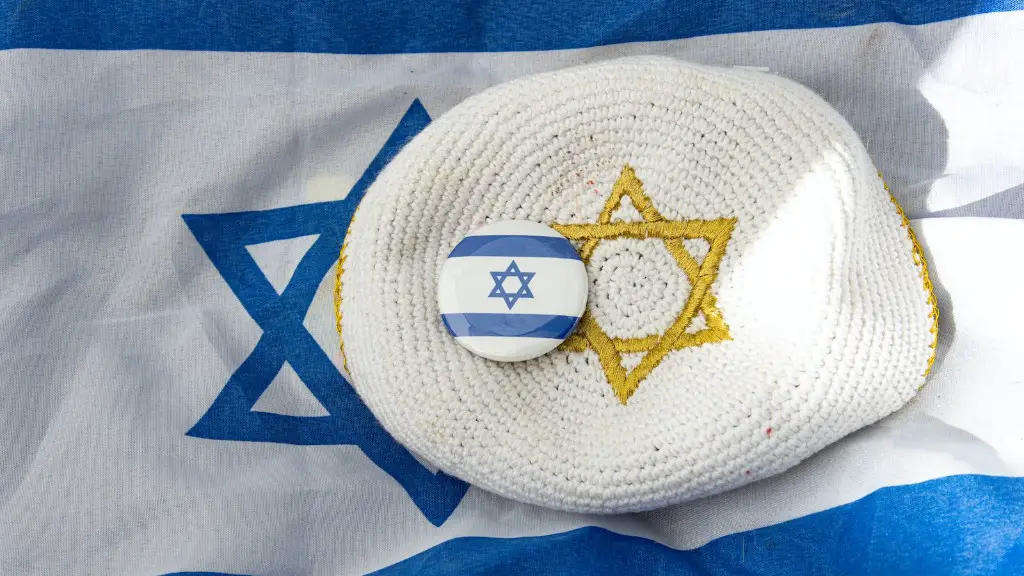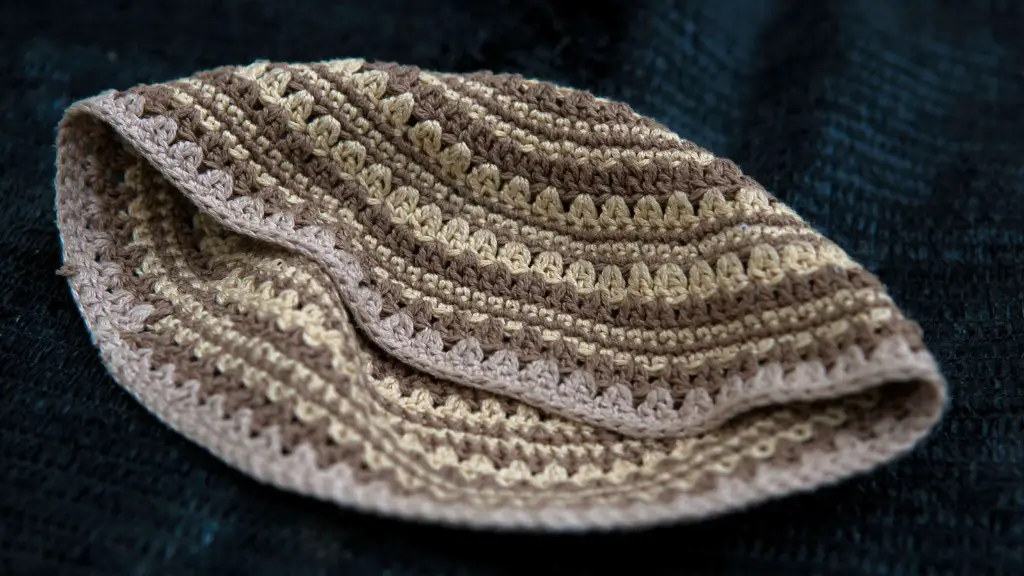The Hamsa hand is a popular symbol across many cultures and faiths. Commonly referred to as the ‘Hand of Fatima’, it is often worn as jewelry or hung on walls as a reminder of protection and good luck. In Judaism, the Hamsa is known as the ‘Hand of Miriam’ and is associated with both religious and secular life. This article takes a closer look at what the Hamsa stands for in Judaism and how it is used.
The origin of the Hamsa is largely a source of debate. Some believe the Hamsa emerged in ancient Mesopotamia, while others believe it originates from the Middle East and North Africa. Nevertheless, it has long been a part of Jewish culture, signifying the power of God, the Creator of all. In fact, the term Hamsa is derived from the Hebrew word ‘Hamesh’, meaning ‘five’ as the symbol itself is composed of five fingers.
The shape of the Hamsa is often thought to represent the five books of Moses (Torah). These books of law, morality and tradition are seen as a powerful protector in Jewish culture. As such, the Hamsa is used as a protective amulet from the threat of harm. From the childbirth room to a daily conversation, the Hamsa is used to shield those in danger from evil energies, bad fortune and negative influences.
In addition to protection, the Hamsa is often used as a symbol of hope and faith. In a Jewish home, it is commonly found on doorways, walls, and around Torahs, serving as a reminder to keep faith in times of difficulty. Its message is one of courage, strength and optimism when everything else may appear hopeless. As the Hamsa is worn by both believers and non-believers alike, its popularity serves as an example of unity, regardless of one’s religious beliefs or background.
When it comes to display and design of the Hamsa, there is a vast amount of spiritual importance attached to it. The overall message imparted is one of hope, faith and protection. The usual design includes a large hand with an eye in its center, serving as a reminder that God is always watching. Many symbols, such as birds and flowers, are often added to Hamsas to highten its spiritual significance.
The Hamsa has become a vital part of the Jewish culture, and it continues to inspire hope and faith among the Jewish community. Through its symbolism, the Hamsa serves to protect Jewish people from the dangers of the world and gives them strength when times are tough. While its popularity may have grown over the years, its spiritual importance remains the same.
What Are Some Cultural Representations of Hamsa In Judaism
Hamsas are popular cultural representations in Judaism, often seen in Jewish households and on jewellery. Most Hamsas have a flat surface, while the reverse side of them is often decorated with symbols, such as flowers, birds, stylised letters or the Star of David. Although most are blue, they are available in a range of colours to suit different personalities and tastes. These symbols vary depending on their purpose and can be used to promote good luck, ward off evil, and signify a deep spiritual connection to Judaism.
Hamsas are often accompanied by inscriptions or images, often relating to the Jewish faith. For example, the phrase “Mizrach”, translated as ‘East’ is a common inscription on both Hamsas and mezuzahs. Similarly, the Magen David or ‘Shield of David’ is the symbol of Judaism and is often used to adorn Hamsas and Talismans.
Some jewellers also use gemstones in their Hamsa designs to highlight the religious significance of the symbol. Some popular gemstones used in Hamsa jewellery include malachite, jade, amulets and others. Some of these stones are believed to bring good luck and protection to the wearer.
The Hamsa is also often found on art in Judaism, with many variations on design. For example, some images feature one, two or three eyes in place of the traditional single eye, while some incorporate meanings from the Kabbalah. Similarly, Hamsa art is often seen in synagogues and libraries, and they are often used in prayer or meditation.
In conclusion, the Hamsa is an important cultural representation in Judaism. It is widely used in households, jewellery and artworks as a symbol of protection, faith, and hope. It is also used to ward off negative energies, bring good luck and to promote a deep spiritual connection with Judaism.
How Is The Hamsa Used for Protection?
In Judaism, the Hamsa is widely used as a talisman for protection from negative energies and bad luck. It is believed that wearing a Hamsa will ward off the evil eye, or in other words, protect the wearer from any harm or adversity. Furthermore, the Hamsa is also thought to bring good fortune, health and prosperity.
The use of the Hamsa dates back centuries and was initially worn by Jewish people as a sign of faith. They believed that wearing a Hamsa would bring them closer to God and protect them from any harm. Traditionally, the Hamsa is a blue colour, however over time, different colours and styles have emerged as representations of faith.
In recent times, the Hamsa is used both in Jewish prayer and symbolism. It is often hung over doorways and windows, placed on mezuzahs, or worn as a pendant, bracelet or necklace. Additionally, it is also common for people to place a Hamsa near their bed or work station as a sign of protection.
Today, although the meaning of the Hamsa remains the same, its usage has evolved. It is now often used as a fashion accessory, a decorative item or a symbol in artworks. The Hamsa has become a popular item and is seen in many places, signifying its spiritual importance and power.
What Is The Significance of Hamsa in Jewish Rituals
The Hamsa is a symbol that is used in many aspects of Jewish ritual and worship. From blessing circles to Shabbat, the Hamsa is seen as a representation of strength, faith, and protection. It encourages faith and perseverance in trying times.
One significant ritual that incorporates the Hamsa is the blessing circle. It is commonly used before the start of prayer, and it involves the gathering of family and friends in a circle. They then form a Hamsa with their hands and recite a blessing for safety and security. This is said to represent the power of God and the strength of unity.
The Hamsa also has an important role in the Jewish Sabbath, or Shabbat. On Shabbat, many Jews will place a Hamsa on the door or in their prayer space as a sign of protection. It is believed that the Hamsa will ward off any negative energy and bring peace to the home. Many will also wear a Hamsa amulet to prayer services during Shabbat.
The Hamsa is also used in the Jewish Torah. It is believed that the hand symbolises the five books of Moses and therefore it is seen as a reminder to keep faith during difficult times. It is also used in the holiday of Hanukkah as a symbol of protection and faith.
In conclusion, the Hamsa serves an important purpose in Jewish rituals and worship. Whilst it is used as a symbol of faith and protection, it is also a reminder of the power of unity and perseverance in trying times.
What is the Difference Between the Hamsa and The Evil Eye?
The Hamsa and the Evil Eye are two closely related symbols with rich histories in Jewish culture. While both possess a symbolic meaning, they have some distinct differences between them.
The Hamsa is a protective symbol and is used to ward off negative energy, bad luck and evil influences. Traditionally, the Hamsa is used as a sign of faith, conveying the message of courage, hope and optimism. It is also believed to possess spiritual powers that can protect the wearer from harm.
In contrast, the Evil Eye is a sign of jealousy, superstition and envy. It is associated with bad luck and misfortune. The Evil Eye is often used to ward off those feelings and is thought to be a curse-like spell, meant to bring harm and misfortune to the recipient.
The origins behind the Hamsa and the Evil Eye are unclear, however, both were likely conceived and adopted in Jewish culture as symbols of faith and protection from evil. Both symbols are commonly seen, particularly on jewellery and artwork, often with symbols and inscriptions to emphasise their meaning.
In summary, the Hamsa and the Evil Eye are two distinct symbols with similar meanings. While the Hamsa is used for protection and faith, the Evil Eye is thought to bring harm and misfortune. Both have deep roots in Jewish culture, and are seen to denote a spiritual connection to God.
What Is The Connection Between Hamsa and Kabbalah?
The connection between the Hamsa and Kabbalah is an important part of Jewish culture. Kabbalah is an ancient Jewish mysticism and it is believed to be the source of the Hamsa’s meaning, message and power.
In Kabbalah, the hand is thought to represent the five books of Moses (the Torah). As such, the Hamsa is seen as a shield of faith, offering protection and guidance. The power of the Hamsa is derived from the spiritual connection to God, and it is believed that keeping faith and wearing a Hamsa amulet will bring luck and protection to its wearer.
In addition to its symbolism in Kabbalah, the Hamsa is also known to have been used in many of the traditional Kabbalistic rituals. For example, during a blessing circle, a Hamsa is formed with hands and used to bring protection to those in attendance. Similarly, many Jews will hang Hamsas in prayer spaces and above doorways for their spiritual meaning.
In conclusion, there is a strong connection between Hamsa and Kabbalah. Kabbalah is thought to be the source of the Hamsa’s power and spiritual importance, and it is widely used in Kabbalistic rituals for protection, faith and guidance. The Hamsa is recognised as a shield of faith and a powerful symbol in Jewish culture.


